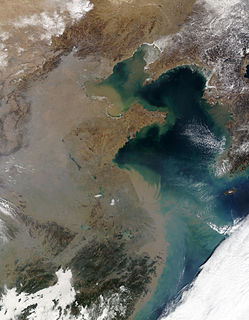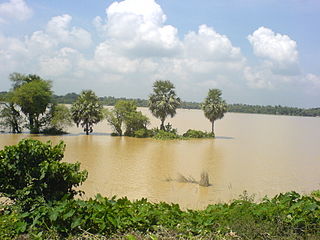 W
WThe climate of India comprises a wide range of weather conditions across a vast geographic scale and varied topography, making generalizations difficult. Climate in north India is generally hotter than south India whereas the South India gets more humid due to nearby coasts. Most parts of the nation don't experience temperatures below 10 °C (50 °F) in winter, and the temperature usually tends to exceed 40 °C (104 °F) during summer. Based on the Köppen system, India hosts six major climatic sub types, ranging from arid deserts in the west, alpine tundra and glaciers in the north, and humid tropical regions supporting rain forests in the southwest and the island territories. Many regions have starkly different microclimates, making it one of the most climatically diverse countries in the world. The country's meteorological department follows the international standard of four seasons with some local adjustments: winter, summer, monsoon (rainy) season, and a post-monsoon period.
 W
WThe Indian Ocean brown cloud or Asian brown cloud is a layer of air pollution that recurrently covers parts of South Asia, namely the northern Indian Ocean, India, and Pakistan. Viewed from satellite photos, the cloud appears as a giant brown stain hanging in the air over much of South Asia and the Indian Ocean every year between January and March, possibly also during earlier and later months. The term was coined in reports from the UNEP Indian Ocean Experiment (INDOEX).
 W
WBlack storms, locally called Kali Andhi in South Asia are violent dust squalls that occur in the late-spring in the northwestern parts of the Indo-Gangetic Plain region of the Indian Subcontinent.
 W
WThe climate of Agra features a semi-arid climate that borders on a humid subtropical climate. The city features mild winters, hot and dry summers and a monsoon season. The monsoon, though substantial in Agra, is not quite as heavy as the monsoon in other parts of India. The average monsoon rainfall during June to September is 628.6 millimeters. Agra has a reputation of being one of the hottest and the coldest towns in India. In summers the city witnesses a sudden surge in temperature and at times, mercury goes beyond the 46 °C mark in addition to a very high level of humidity. During summer, the daytime temperature hovers around 46-50 °C. Nights are relatively cooler and temperature lowers to a comfortable 30 °C. Winters are bit chilly but are the best time to visit Agra. The minimum temperature sometimes goes as low as -2 or -2.5 °C but usually hovers in the range of 6 to 8 °C.
 W
WThe Climate of Rajasthan in northwestern India is generally arid or semi-arid and features fairly hot temperatures over the year with extreme temperatures in both summer and winter.
 W
WThe Climate of Tamil Nadu, India is generally tropical and features fairly hot temperatures over the year except during the monsoon seasons.
 W
WDrought in India has resulted in tens of millions of deaths over the 18th, 19th, and 20th centuries. Indian agriculture is heavily dependent on the country's climate: a favorable southwest summer monsoon is critical to securing water for irrigating India's crops. In parts of India, failure of the monsoons causes water shortages, resulting in below-average crop yields. This is particularly true of major drought-prone regions such as southern and eastern Maharashtra, northern Karnataka, Andhra Pradesh, Odisha, Gujarat, Telangana, and Rajasthan.
 W
WThe Loo is a strong, dusty, gusty, hot and dry summer wind from the west which blows over the western Indo-Gangetic Plain region of North India and Pakistan. It is especially strong in the months of May and June. Due to its very high temperatures, exposure to it often leads to fatal heatstrokes.
 W
WMonsoon is a 2014 Canadian documentary film by Sturla Gunnarsson about the monsoon weather system in India.
 W
WThe monsoon of South Asia is among several geographically distributed global monsoons. It affects the Indian subcontinent, where it is one of the oldest and most anticipated weather phenomena and an economically important pattern every year from June through September, but it is only partly understood and notoriously difficult to predict. Several theories have been proposed to explain the origin, process, strength, variability, distribution, and general vagaries of the monsoon, but understanding and predictability are still evolving.
 W
WNatural disasters in India, many of them related to the climate of India, cause massive losses of life and property. Droughts, flash floods, cyclones, avalanches, landslides brought by torrential rains, and snowstorms pose the greatest threats. A natural disaster might be caused by earthquakes, flooding, volcanic eruption, landslides, hurricanes etc. In order to be classified as a disaster, it will need to have a profound environmental effect and/or human loss and frequently incurs a financial loss. Other dangers include frequent summer dust storms, which usually track from north to south; they cause extensive property damage in North India and deposit large amounts of dust and dirt from arid regions. Hail is also common in parts of India, causing severe damage to standing crops such as rice and wheat and many more crops.
 W
WThe state of Karnataka in India has a bittersweet relationship with rains. While its regions of Malnad and Coastal Karnataka receive copious amount of rainfall; its north Bayaluseemae region in the Deccan Plateau is one of the most arid regions in the country. Most of the rains received in the state is during the monsoon season. Being an agrarian economy with a large percentage of its citizens engaged in agriculture, the failure of rains can have a crippling effect on the economy of the state. Apart from the benefits in agriculture, the Government of Karnataka has tried to avail other benefits of rainfall using scientific methods. An example of this is the project, Rainwater Harvesting in Rural Karnataka which is initiated by the Karnataka State Council for Science and Technology and is one of the largest rainwater harvesting projects in the world. Agumbe in the Shimoga district, Amagaon in Belgaum District, Hulikal again in Shimoga district and Talakaveri in Madikeri are some of the known places with the highest annual rainfall in South India. Of this Amagaon has received over 10000 mm rain fall twice in 10 years.
 W
WThe climate of West Bengal varies from tropical savannah in the southern portions to humid subtropical in the north.
 W
WA western disturbance is an extratropical storm originating in the Mediterranean region that brings sudden winter rain to the northwestern parts of the Indian subcontinent. It is a non-monsoonal precipitation pattern driven by the westerlies. The moisture in these storms usually originates over the Mediterranean Sea, the Caspian Sea and the Black Sea. Extratropical storms are a global phenomena with moisture usually carried in the upper atmosphere, unlike their tropical counterparts where the moisture is carried in the lower atmosphere. In the case of the Indian subcontinent, moisture is sometimes shed as rain when the storm system encounters the Himalayas. western disturbances are more frequent and strong in winter season.
 W
W